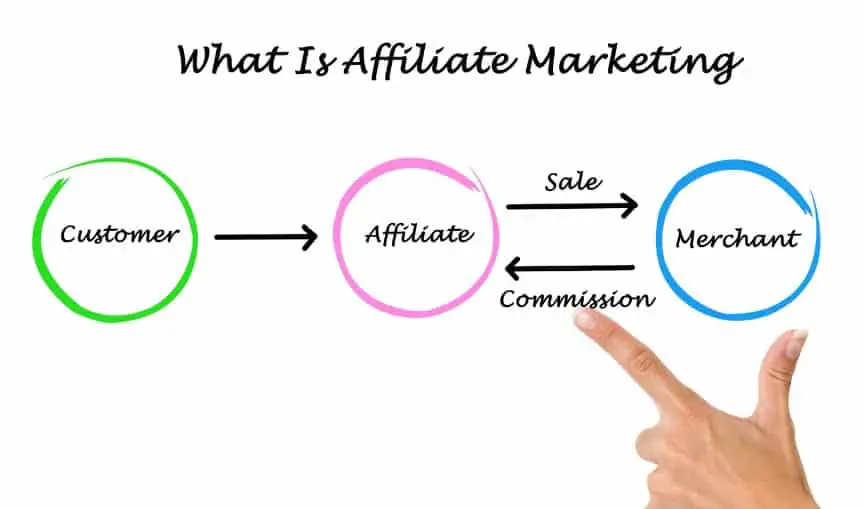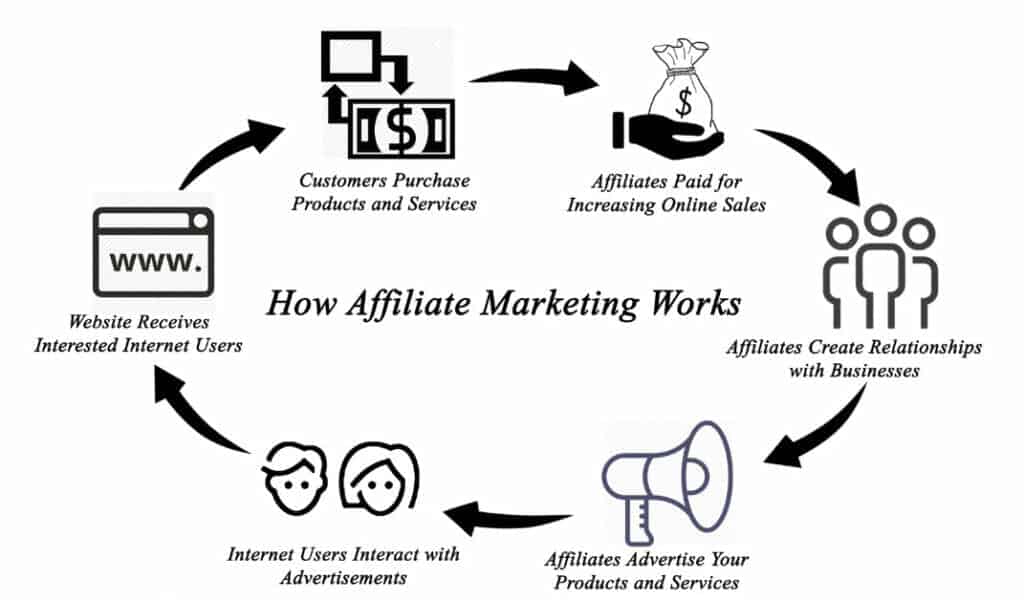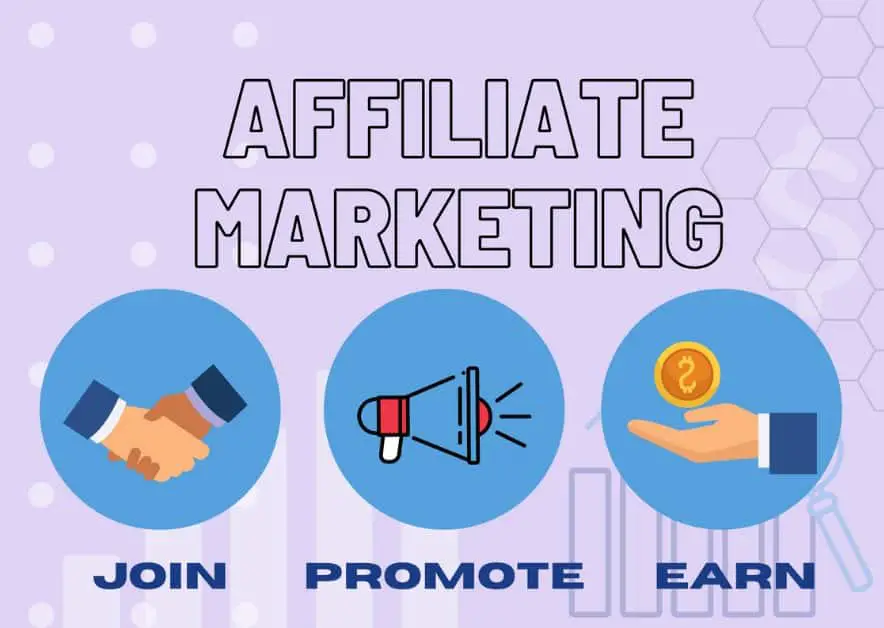How to Start Affiliate Marketing for Blogs: The Ultimate Guide
Affiliate marketing can be a great way to monetize your blog and generate some extra income. There are many ways to get started in affiliate marketing. In this guide, we will walk you through the process step-by-step.
We will discuss what affiliate marketing is, how it works, and the different types of programs you can join. Then we will show you how to start affiliate marketing for blogs, create effective affiliate marketing links and promote your content on social media. Finally, we will give you some tips for optimizing your website for conversions. Let's get started!
DISCLOSURE: Some of the links that I share in this article ARE my affiliate links. This means I may earn a commission, at no extra cost to you. In fact, sometimes you'll get a discount or free credits just FOR using my link. 🙂
What is affiliate marketing?

Affiliate marketing is a type of performance-based marketing in which a business rewards an affiliate for each visitor or customer brought to the site by the affiliate's marketing efforts.
In other words, affiliate marketing is a way for businesses to compensate third-party websites for traffic and sales generated through their referrals.
How does affiliate marketing work?
The Affiliate Marketing industry is composed of four main players: the merchant (also known as ‘retailer' or ‘brand'), the network (which provides the affiliate with offers and also handles payments), the publisher (also known as ‘the affiliate'), and the customer. As the market expands, a wide range of players have emerged, including specialized third-party vendors, super-affiliates, and managed affiliate programs with affiliate managers.
The merchant can be an online retailer like Amazon or a service provider. Associates (publishers) sign up with the merchant and agree to promote their products or services on their website or blog. In return, they receive a commission for every customer that they refer to the merchant's site. When a customer clicks on one of the affiliate's links and makes a purchase, the affiliate earns a commission.
The process typically works like this:
1. The affiliate finds a product or service to promote on their website.
2. They create an effective promotional banner or text link and add it to their website.
3. When a visitor clicks on the referral link, they are redirected to the business's website.
4. If the visitor makes a purchase, the affiliate earns a commission.

The merchant is not the only one who benefits from affiliate marketing. The affiliates also get something out of it. They can generate traffic to their website or blog that they would not have otherwise had. And, if they do it right, they can make some money from it.
What are the pros and cons of affiliate marketing?
The Pros
The pros of affiliate marketing as compared to other online business models are listed below. It is a relatively easy way to get started in online marketing.
No need to do customer support
Affiliate marketers don't have to worry about customer service or product fulfillment as the merchants are the ones who deal with those. They are only responsible for generating traffic and sales for the business.
Can be a passive income stream
Affiliate marketing can be a passive income stream if you choose the right products and promote them effectively. You can set up an affiliate website or blog and then simply let it run on autopilot, making money while you sleep.
Work from home

One pro of affiliate marketing is that it allows you to work from home. This can be a great option for people who want to stay home with their children, or for those who want to avoid the commute to and from work.
It can also be a good option for people who are looking for flexibility in their work schedule
Cost-effective
Affiliate marketing can be a cost-effective way to make money online since it is relatively easy to get started, and it doesn't need investment to create a physical product or buying inventory. This type of income stream works great if you want to trade your skills or knowledge for financial gain.
Convenient and flexible
Affiliate marketing is a flexible way to work as you can do it part time or full-time depending on your needs and goals. It allows you to work on your own time and set your own targets. You also have the freedom to work on what interests you.
Performance-based rewards
You can work as little or as much as you want and your success depends on how much effort you put into learning new skills.
The Cons
The cons of affiliate marketing are listed below:
Low barriers to entry – Very competitive
Since there are low barriers to entry, this means that anyone with a computer and an internet connection can start working as an affiliate marketer. It can thus be quite competitive, and you will need to put in the work to stand out from the crowd.
The learning curve to get started
Other cons of affiliate marketing are that it can be a bit of a learning curve to get started. You will need to learn how to find products and services to promote, as well as how to create effective promotional materials. You will also need to learn about different affiliate networks and how they work.
You need to invest time and effort

It may take some time (months or years) to build up traction with search engines like Google and Bing to get organic traffic to your blog. It's difficult to make money if you are not generating a lot of traffic, and it's challenging to track your results.
It can be a bit of a slow start until you build up a good-sized audience. You will need to put in the work to create content that is compelling and effective at driving traffic and affiliate sales and you need ongoing effort to maintain it.
You're not in control
As an affiliate marketer, you are not in control of the product or service you are promoting. If the product or service you are promoting turns out to be not up to standard, then you may lose your credibility and trust from your audience.
How do you know whether affiliate marketing is right for you?
Now that you know the pros and cons of affiliate marketing, you may wonder whether it is right for you. Here are some questions to help you decide:
Do I have time to invest? Affiliate marketing can be a bit of a time commitment, especially in the beginning. You will need to create content, build an audience, and track your results. If you don't have the time to invest, then affiliate marketing may not be right for you.
Do I have a blog or a website? To start affiliate marketing for blogs, you will need a blog or website. This is where you will promote the products or services that you are promoting.
If you don't have a blog or website yet, then you will need to create one for this to work. If you already have a blog or website, that's great as you already have a head-start!
Do I have an audience? To make money from affiliate marketing, you will need to have an audience. This can be as a blog following, social media followers, or email subscribers. If you don't have an audience, then you need to build one.
If you think that affiliate marketing is right for you, we will take you step by step on how to start affiliate marketing on your blog next.
How to Start Affiliate Marketing for Blogs

Step 1: Start a Blog for Affiliate Marketing
As mentioned earlier, if you want to start affiliate marketing, the first thing you need is a blog. This is where you will promote the products or services that you are promoting.
If you don't have a blog yet, then you will need to create one. Once you have a blog, the next step is to build an audience. This can be as a blog following, social media followers, or email subscribers.
You then need to create content that is compelling at driving traffic. This takes time and effort, but it is worth it in the end. Once you have started generating traffic, it's time to look for affiliate programs. There are many affiliate programs out there, so find one that fits your niche and audience.
Different types of affiliate marketing programs
There are several types of affiliate marketing programs. The three most common types of affiliate marketing programs are pay-per-click, pay-per-sale, and pay-per-lead.
Pay-per-click (PPC) affiliate marketing programs pay you based on the number of clicks that your readers make on the affiliate links in your blog posts. This type of program is best suited for blogs with a lot of traffic.
Pay-per-sale (PPS) affiliate marketing programs pay you based on the number of affiliate sales that are made through the affiliate links in your blog posts. This type of program is best suited for blogs with a small but engaged readership.
Pay-per-lead (PPL) affiliate marketing programs pay you based on the number of leads that are generated through the affiliate links in your blog posts. This type of program is best suited for blogs with a large readership.
Choosing the right affiliate marketing program for your blog
Once you know which type of program is best suited for your blog, you can start researching different affiliate networks and programs. There are a few things you should consider when choosing an affiliate marketing program:
– Does the program offer products or services that are relevant to your blog?
– How much traffic does your blog generate?
– How engaged is your readership?
– What is the commission structure?
– How easy is it to use the affiliate links in your blog posts?
When choosing an affiliate marketing program, it's important to consider the type of product or service that you're promoting. For example, if you're promoting a physical product, then a pay-per-sale program may be more appropriate than a pay-per-click program. If you're promoting a service, then a pay-per-lead program may be more appropriate than a pay-per-click or pay-per-sale program.
Finally, it's important to consider the payment terms of the affiliate marketing program. Some programs give monthly payment, while others pay quarterly or annually. Choose a program that fits your blogging schedule and cash flow needs.
Once you've considered these factors, you should be able to choose the right affiliate marketing program for your blog.
Tips to get started
Here are a few tips to get you started:
– Look for programs that offer products or services that apply to your blog's niche.
– Look for programs with high affiliate commissions.
– Look for programs with favorable payment terms.
– Look for programs that provide effective promotional materials.
By following these tips, you can find the perfect affiliate marketing program for your blog and start earning commissions from sales or leads that are generated through your blog.
Step 2: Choose the Product or Service You Want to Promote
Now that you know how to choose the right affiliate marketing program for your blog, it's time to choose the product or service that you want to promote.
Types of Affiliate Products: Physical vs. Information vs. Services
There are three main types of affiliate products: physical products, information products, and services. Physical products are items that can be shipped and delivered to the customer. These could include items such as books, DVDs, or furniture.
Information products are digital products that can be downloaded by the customer. These could include e-books, software, or online courses. Services are intangible work provided by someone else. These could include things such as web hosting or search engine optimization.
Below is a table showing the advantages and disadvantages associated with each type of products:
| Advantages | Disadvantages | |
| Physical Products | – Can be shipped to the customer – Customers can touch and feel the product – Often have a higher perceived value than digital products | – Can be expensive to ship – Can be damaged in transit – Customers may need to wait for the product to be delivered |
| Information Products | – Can be downloaded immediately by the customer – Often have a lower price point than physical products | – Customers cannot touch or feel the product before they buy it – Can be difficult to create effective promotional materials for digital products |
| Services | – Services are intangible and can't be damaged – Services can be delivered immediately – Customers can often try before they buy | – Services can be hard to promote – Services may have a lower perceived value than physical products |
You can read more about finding the right product for your target audience here: How to Find Affiliate Marketing Products for Your Target Audience
Join an Affiliate Network
Now that you know the different types of affiliate products, it's time to join an affiliate network. An affiliate network is a company that connects advertisers with publishers. This is where you will find the products and services that you can promote as an affiliate marketer.
Affiliate networks work with a variety of different advertisers and publishers, so it's important to choose one that has the products and services that you're interested in promoting. It's important to choose a network that has an excellent reputation and offers high commissions.
There are several affiliate networks to choose from, but some of the most popular ones include:
– Amazon Affiliate (also known as Amazon Associates)
– Commission Junction (CJ Affiliate)
Step 3: Set Up as an Affiliate
Once you've joined an affiliate network, it's time to sign up for an affiliate program. An affiliate program is a specific partnership between an advertiser and a publisher. When you sign up for an affiliate program, you agree to promote the products or services of a specific advertiser on your blog or website.
If you're not sure which type of product to promote, think about the types of products or services that your target audience is interested in. For example, if your blog is about fashion, then promote products or services that are related to fashion.
Consider whether you have the skills and resources necessary to promote a physical product, digital product, or service.
Promote the Products and Services You Use
When choosing affiliate products to promote, it's important to promote products and services that you use and believe in. This will help you create effective promotional materials and increase the chances of making a sale.
Promoting products and services that you use will help you build trust with your readers. They will know that you're not just promoting a product or service for the sake of making a commission; you're promoting it because you believe in it and think it's the best option for them.
What You Need To Note
In exchange for promoting the advertiser's products or services, you will earn a commission on any sales that you generate. The commission rate and payment terms will vary depending on the affiliate program you've joined. When setting up an affiliate account, you should know what type of payment plan the program offers.
Some affiliate programs will need you to have a certain amount of traffic before you can join, while others will allow you to join immediately. It's important to read the requirements of each program carefully before signing up.
It's also important to consider the commission rate and the payment terms of the product or service you're promoting. For example, if you're promoting a physical product with a high commission rate, then promote that product through a pay-per-sale program.
Finally, it's important to remember that you don't have to promote every product or service that's offered by the affiliate marketing program you've joined. You can choose to promote only those products or services that you're interested in and that apply to your blog's niche.
Step 4: Promote the Product
After you have signed up for the affiliate programs, you can start promoting the products! There are several ways to promote affiliate products on your blog or website.
Some common methods include:
– Writing product reviews
– Creating product roundups
– Creating How-To guides
– Promoting special deals and coupons
– Adding product banners and links to your sidebar or header
We will elaborate more on a few methods below:
Create a Resource Page on Your Blog
One of the best ways to promote a product or service is to create a resource page on your blog. A resource page is a page on your blog that features a list of products or services that you recommend.
When creating a resource page, be sure to include a variety of different products and services that your audience may be interested in. Be sure to include links to the products and services that you're promoting, as well as descriptions of each product or service.
As an example, I have a Best Business Resources I Use In My Business page that you can access from my blog menu, as shown in the picture below:

Creating a resource page is a great way to show your readers that you're an authority on the topic. It will also help you generate traffic and leads from potential customers.
Create Custom Content For Promotion
This content marketing strategy involves creating unique content that is specific to your brand and audience. Your goal should be to create and promote custom content that applies to your niche or industry. When promoting your content, you must ensure that it meets all the guidelines set forth by Google. You can do this by through:
Write Product Reviews
One of the best ways to promote a product or service is to write a review about it on your blog. When writing a review, be sure to include a description of the product or service, as well as your thoughts and impressions.
Be sure to include links to the products or services that you're promoting, as well as images if possible. Writing reviews is a great way to show your readers that you're an authority on the topic. It will also help you generate traffic and leads from potential customers.
Product Comparisons
Comparisons are a great way to show your readers how your recommended products stack up against the competition. When writing a product comparison, be sure to include a table that compares the features of each product and also links to the products or services that you're promoting, as well as images, if possible.
Create content that doesn't feel like a sales pitch
Focus on providing great content on a related topic. This way, you can use your content to “soft sell” your product while still keeping the focus on education.
Create Valuable Bonus Content
If you want to increase the chances of making a sale, then you should create valuable bonus content. Bonus content is content that is offered to readers for free when they buy a product or service through your affiliate link.
This could include an eBook, video series, or even a discount code. By offering this type of content, you'll be able to increase the chances of making a sale, and you'll also be able to build trust with your readers.
Create Helpful Tutorials
If you want to promote a product or service, then you should consider creating a tutorial. A tutorial is a great way to show your readers how to use the product or service that you're promoting.
When creating a tutorial, be sure to include images and step-by-step instructions and links to the products or services that you're promoting. By creating a tutorial, you'll be able to show your readers how easy it is to use the product or service that you're recommending.
Include Links in Your Blog Posts
Whenever you write a blog post about affiliate marketing, be sure to include links to the products or services that you're promoting. This will help your readers learn more about the products and services that you're recommending, and it will also help them find the products and services that they're interested in buying.
Including links in your blog posts is a great way to increase the chances of making a sale. When readers click on the links in your blog post, they'll be taken to a page where they can learn more about the product or service that you're promoting. They may also be encouraged to buy the product or service that you're recommending.
Using an Email Series to Start Affiliate Marketing
If you have an email list, then you should consider using an email marketing to start affiliate marketing. An email series is a great way to promote a product or service to your subscribers.
When creating an email series, be sure to include images and links to the products or services that you're promoting. Include a call-to-action in each email. By using an email series, you'll be able to reach many people with your affiliate marketing message.
It's important to experiment with different methods of promotion to see what works best for you and your blog. You may find that some methods work better than others, or that certain products are more successful than others.
Comply with Legal Requirements
When you're ready to start affiliate marketing, be sure to follow all legal requirements in your jurisdiction. This includes disclosing your relationships with any affiliates on your blog. I do this by adding an affiliate disclosure statement at the start of every blog article and I also specify clearly in my blog terms and conditions page.
In the U.S., the Federal Trade Commission (FTC) requires that you let people know you'll earn a commission.
Some affiliate programs also require you to include in your terms and conditions such disclosure. For example, Amazon Affiliate program stated that “To meet the Associate Program's requirements, you must (1) include a legally compliant disclosure with your links and (2) identify yourself on your Site as an Amazon Associate with the language required by the Operating Agreement.”
Last but not least, avoid using any affiliate links in spammy or deceptive content. This could cause your affiliate account being banned, and you being blacklisted from other affiliate programs.
Step 5: Get Paid – Repeat
The last step is to get paid. This usually happens monthly, and you'll receive a commission for each sale that you generate. Be sure to keep track of your sales so that you can accurately report your earnings to your affiliate program.
As long as you continue to produce quality content and promote products that apply to your niche, then you should be able to generate a steady affiliate income from affiliate marketing. Just remember to be patient, as it can take some time to build up a significant following.
How to create effective affiliate links
Adding affiliate links to your blog posts is a simple process. To create a text link, simply highlight the text you want to be linked to and click on the “link” button in your blog post editor.
To create a banner link, simply copy the HTML code for the banner that you want to use and paste it into your blog post editor. When adding affiliate links to your blog posts, be sure to use effective promotional copy.
For example, rather than just writing “click here to buy” try writing a more compelling call-to-action such as “save 50% on your next purchase.”
It's also important to use effective keywords in your affiliate links. For example, if you're promoting a product that is related to “Paleo diet,” be sure to use that keyword in the anchor text of your affiliate link. This will help improve the chances that your readers will click on the link and make a purchase.
To know more about keyword research and ranking for the right keywords, refer to OptinMonster's keyword research guide.
Finally, be sure to test your affiliate links before you publish your blog post. This will ensure that the links are working properly and that your readers are being redirected to the correct page on the merchant's website.
By following these tips, you can start adding affiliate marketing links to your blog posts and earn commissions from sales or leads that are generated through your blog.

When promoting your content on social media, be sure to use effective graphics and copy. For example, rather than just writing “check out my latest blog post,” try using a more compelling call-to-action such as “save 50% on your next purchase.”
Make sure you use relevant hashtags when promoting your content on social media. This will help increase the chances that your followers will see your post and click on the link to read your blog post.
Finally, don't forget to include a link to your blog post in your social media profile. This will ensure that even if your followers don't see your post, they can still click through to your blog and read your latest content.
5. Tips for optimizing your website for conversions
With affiliate marketing, it's important to optimize your website for higher conversion rates. This means that you need to make sure that your website is designed in a way that encourages your readers to click on your affiliate links and make a purchase.
Here are a few tips for optimizing your website for conversions:
– Use effective graphics and copy.
– Optimize your website for search engine traffic.
– Include an email sign-up form on your website and also link to your social media channels.
– Include a call-to-action on every page of your website and use effective call-to-action phrases on your website.
– Add share buttons on all of your blog posts so that they can be shared easily.
If you would like to read more, you can check out the following: 12 Best Affiliate Marketing Tips For Beginners To Succeed
Conclusion
Starting affiliate marketing for blogs can be a great way to earn some extra money or to make a full-time income. However, it's important to remember that affiliate marketing is a long-term strategy. It may take some time to see results.
But if you are ready to put in the work to be consistent and create high-quality content, then affiliate marketing can be a great opportunity for you. Now that you know how to start affiliate marketing for your blog, it's time to get started!
Thanks for reading! I hope this article was helpful. If you have any questions, please leave a comment below. Cheers!
P.S. If you want to learn more about how you can start affiliate marketing on the right footing, then check out my blog post: The Best Affiliate Marketing Classes for Beginners







